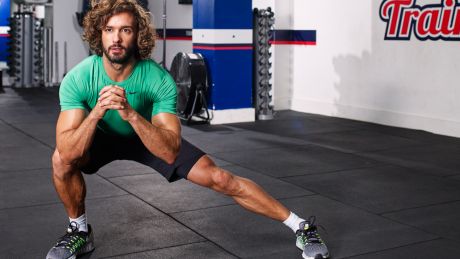How To Do The Side Lunge
Go lateral with the classic lunge to increase your strength, balance and co-ordination

Photograph: Glen Burrows
The lunge, and indeed the reverse lunge, are fantastic lower-body exercises, but they have one serious flaw – they only require you to move forwards and backwards. That’s a problem since sometimes you’re required to move sideways, because life doesn’t always come at you head on.
As well as enlisting a couple of extra muscles on your inner and outer thighs that the forwards-and-backwards lunges can’t reach, the side lunge, or lateral lunge, will also improve sports performance – you’ll be jinking around defenders like Lionel Messi and leaping to make astonishing diving catches like Jonty Rhodes in no time. (We’ll concede the former South African cricketer is not quite as famous as Lionel Messi, but hot damn was he one hell of a fielder. The man must have been side lunging 24/7.)
The main muscles worked by the side lunge are the quads and glutes, as is the case with the standard and reverse lunge, but the extra focus on the inner and outer thighs means it’s an exercise you should have in your repertoire even if you have no intention of playing sports because it will contribute to the functional strength of your lower body.
How To Do The Side Lunge
Start by standing tall with your feet parallel and shoulder-width apart. Your back should be straight and your weight on your heels. Take a big step to the side and, ensuring you keep your torso as upright as possible, lower until the knee of your leading leg is bent at around 90°, keeping your trailing leg straight. Push back up and return to the starting position.
The most common form issue with a side lunge is to collapse over the straight knee. Focus on bending and lowering from the hips, with your back straight and core engaged, as with a squat. Also make sure you’re keeping the heels of both feet on the floor as you lower.
You can do several side lunges on one leg then switch sides, or alternate legs. Shoot for 20 side lunges on each leg in total, or build them into a timed circuits routine.
Get the Coach Newsletter
Sign up for workout ideas, training advice, reviews of the latest gear and more.
Side Lunge Variations
Dumbbell side lunge
Once you’re comfortable with the movement, the best way to increase the difficulty of the side lunge is to hold a dumbbell in each hand. Keep the dumbbells in front of you, with your palms facing your body and your arms hanging straight as you move, but don’t let them pull your torso down and out of position while lunging. That is unless you are performing the side lunge and touch, which is a further progression of the exercise. In this variation, once you’ve stepping into a side lunge you bend forwards at the hips and lower the dumbbells to the floor by your leading leg, keeping your back straight.
Leaping side lunge
Adding a leap between lunges ramps up the cardio benefits of the exercise and also increases the demands of maintaining good form throughout the movement, so your core strength should benefit all the more.
Stand with your feet together. Take a large step out to the right and squat on that side with your bodyweight over your right knee, which should be bent at a 90° angle, while your left leg is straight. So far, you’ve just followed the standard side lunge technique, but from here it gets funky. Instead of simply stepping your right foot back into the middle, you leap, moving your right leg back and then straightening it as you lunge out over your left side, aiming to land softly and move smoothly throughout.
See related
- Do This Leg Workout At Home To Strengthen Your Lower Body
- A Quick-Fire Full-Body TRX Circuit
- The Best Leg Exercises For All Levels Of Gym-Goer
Transverse lunge
This hip-opening side lunge variation will prepare your body for the sudden twists and turns involved in sports like football, so your body doesn’t seize up when you’re trying to tackle a tricky winger.
Stand with your feet together. You can hold dumbbells by your sides to make the exercise tougher. Take a big step to one side and turn the leading foot so it is at a right angle to your standing foot, twisting around so your chest is facing sideways from your original position. Lower until the knee on your leading leg is bent at around 90°, keeping the trailing leg straight, then push back up.
Cable side lunge
One of the great benefits of the cable machine is that it can provide sideways resistance for your side lunges, which dumbbells and other free weights can’t. Stand side-on to a low cable, holding the attachment in both hands by your hips. Take a big step towards the machine to lower the weight, then push back up to standing.

Nick Harris-Fry is a journalist who has been covering health and fitness since 2015. Nick is an avid runner, covering 70-110km a week, which gives him ample opportunity to test a wide range of running shoes and running gear. He is also the chief tester for fitness trackers and running watches, treadmills and exercise bikes, and workout headphones.









